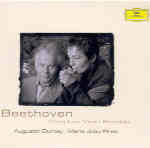This is really splendid! Dumay and Pires have made some outstanding recordings, including an excellent disc of Brahms violin sonatas, and this new set of Beethoven’s complete works in the same genre, generously annotated and very attractively packaged, belongs among the very best available. Everyone will have their own favorite moments in these popular pieces, so any discussion of the performances is bound to leave much unsaid, but to get started just listen to the beginning of Disc 2, to the way the opening Allegro assai of Sonata No. 8 leaps from the speakers. Before two seconds have elapsed you know that these performances will have all of the fire, passion, and spontaneity that Beethoven ideally requires.
In the early sonatas, Dumay and Pires attack the swift outer movements (and this is some of the most energetic music that Beethoven wrote) with uninhibited freshness, and despite Dumay’s enthusiasm at such points as the opening Presto of No. 4, his tone never turns unnecessarily coarse. The duo takes special care to imbue the variation movements (in Nos. 1, 6, and of course the “Kreutzer”) with plenty of variety and character. Note how the sweetly innocent opening of the “Spring” Sonata rapidly accumulates energy as the exposition proceeds, or the way in which these players knit together the broken phrases of the Kreutzer’s opening adagio, carrying the music’s momentum through the pauses and eruptive exclamations. Pay particular attention to the spiky accents in the outer section of No. 10’s tiny scherzo (the one Mahler quotes in the scherzo of his Second Symphony), its lilting trio offering the strongest possible rhythmic contrast. The stormy finale of the C minor Sonata (No. 7) contains playing of such fire and passion that even Argerich/Kremer might pale in comparison.
In terms of ensemble balance, Dumay stands obviously in front of his partner, but the very clear recording allows every detail of Pires’ playing to be heard, and she’s no second fiddle, as her contributions (particularly in the early sonatas and the “Kreutzer”) make abundantly clear. In fact, this is certainly one of the better-equalized duos to record these works, superior in this particular respect to Argerich/Kremer, Oistrakh/Oborin, or even Perlman/Ashkenazy. A case in point: listen to the perfectly balanced and tuned unisons in the second subject of the Kreutzer’s first movement. Make no mistake, this is chamber music playing of the first order, and a major contribution to the Beethoven discography–a set to be savored and enjoyed many times over. [11/23/2002]
































